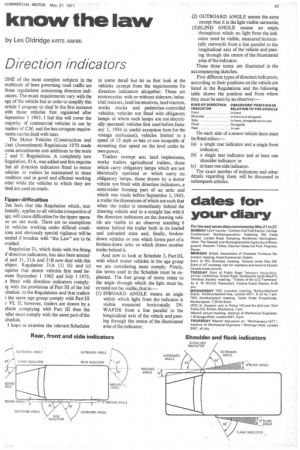Direction indicators
Page 65

If you've noticed an error in this article please click here to report it so we can fix it.
by Les Oldridge AIRTE, AM IMI ONE of the most complex subjects in the multitude of laws governing road traffic are those regulations concerning direction indicators. The exact requirements vary with the age of the vehicle but in order to simplify this article 1 propose to deal in the first instance with those vehicles first registered after September 1 1965. I feel this will cover the majority of commercial vehicles in use by readers of CM, and the less stringent requirements can be dealt with later.
The Motor Vehicles (Construction and Use) (Amendment) Regulations 1970 made ;mile amendments and additions to the main -2 and U Regulations. A completely new Regulation, 81A, was added and this requires that all direction indicators fitted to motor rehicles or trailers be maintained in clean .ondition and in good and efficient working irder while the vehicles to which they are keel are used on roads.
ripper difficulties Dne feels that this Regulation which, incilentally, applies to all vehicles irrespective of ige, will cause difficulties for the tipper operaor on site work. There are no exemptions 'or vehicles working under difficult condiions and obviously special vigilance will be ieeded if brushes with "the Law" are to be ivoided.
Regulation 31, which deals with the fitting f direction indicators, has also been amend;c1 and 31, 31A and 31B now deal with this ubject. Regulation 31A (1) (b) and (c) equires that motor vehicles first used beween September 1 1965 and July 11973, e fitted with direction indicators complyig with the provisions of Part HI of the 3rd chedule to the Regulations and that trailers the same age group comply with Partin r VI. If, however, trailers are drawn by a chicle complying with Part III then the 'alter must comply with the same part of the chedule.
I hope to examine the relevant Schedules in some detail but let us first look at the vehicles exempt from the requirements for direction indicators altogether. These are motorcycles with or without sidecars; industrial tractors, land locomotives, land tractors, works trucks and pedestrian-controlled vehicles; vehicles not fitted with obligatory lamps or where such lamps are not electrically operated; vehicles first used before January 1, 1936 (a useful exception here for the vintage enthusiast); vehicles limited to a speed of 15 mph or less or one incapable of exceeding that speed on the level under its own power.
Trailers exempt are; land implements, works trailers agricultural trailers, those which carry obligatory lamps which are not electrically operated or which carry no obligatory lamps, those drawn by a motor vehicle not fitted with direction indicators, a semi-trailer forming part of an artic and which was made before September 1, 1965, a trailer the dimensions of which are such that when the trailer is immediately behind the drawing vehicle and in a straight line with it the direction indicators on the drawing vehicle are visible to an observer standing. 6 metres behind the trailer both in its loaded and unloaded state and, finally, brokendown vehicles or one which forms part of a broken-down artic or which draws another trailer behind it.
And now to look at Schedule 3, Part III, with which motor vehicles in the age group we are considering must comply. Firstly, the terms used in the Schedule must be explained. The first group of terms relate to the angle through which the light must be, or need not be, visible, that is—
(1) INBOARD ANGLE means an angle within which light from the indicator is visible measured horizontally INWAP DS from a line parallel to the longitudinal axis of the vehicle and passing through the centre of the illuminated area of the indicator; (2) OUTBOARD ANGLE means the same except that it is the light visible outwards; (3)BLIND ANGLE means an angle, throughout which no light from the indicator need be visible, measured horizontally outwards from a line parallel to the longitudinal axis of the vehicle and passing through the centre of the illuminated area of the indicator.
These three terms are illustrated in the accompanying sketches.
Five different types of direction indicators, according to their positions on the vehicle are listed in the Regulations and the following table shows the position and from where they must be seen by an observer:— KIND OF DIRECTION OBSERVERS POSITION IN
INDICATOR RELATION TO THE VEHICLE Front In front Shoulder In front and alongside Side In front, alongside and in rear Flank Alongside Rear In rear
On each side of a motor vehicle there must be fitted either:—
(a) a single rear indicator and a single front indicator; (b) a single rear indicator and at least one shoulder indicator. or (c) at least one side indicator.
The exact number of indicators and other details regarding them will be discussed in subsequent articles.






























































































































